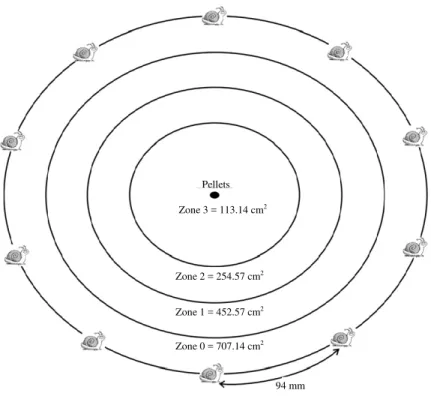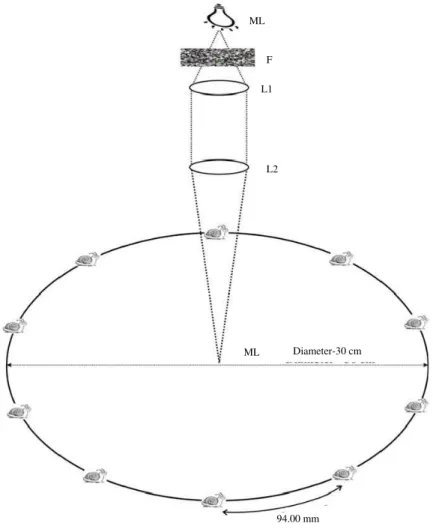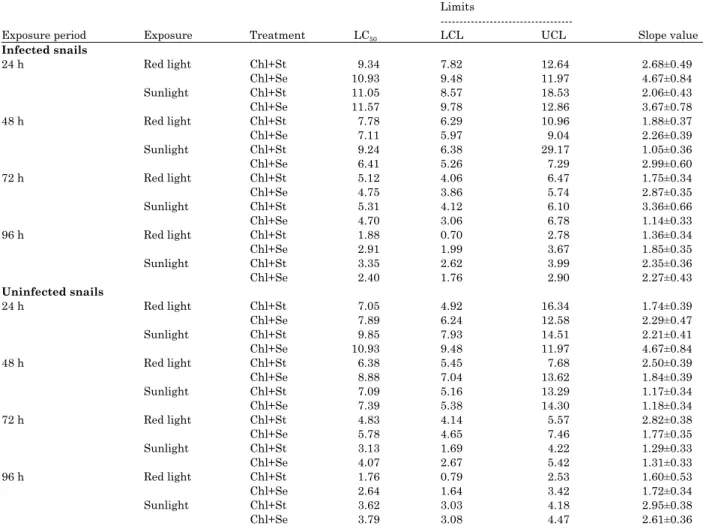International Journal of Zoological Research 11 (5): 207-214, 2015 ISSN 1811-9778 / DOI: 10.3923/ijzr.2015.207.214
© 2015 Academic Journals Inc.
Bait Formulations of Chlorophyllin against Infected/Uninfected
Lymnaea acuminata
in Red and Sunlight
Navneet Kumar and Vinay Kumar Singh
Malacology Laboratory, Department of Zoology, D.D.U. Gorakhpur University, Gorakhpur, Uttar Pradesh, 273 009, India
Corresponding Author: Vinay Kumar Singh, Malacology Laboratory, Department of Zoology, D.D.U. Gorakhpur University, Gorakhpur, Uttar Pradesh, 273 009, India Tel: +91-551-2202187, +91-9415855488
ABSTRACT
Control of snail population is an important tool in fasciolosis control programme. In order to achive this objective the method of bait formulation containing an attractant and a molluscicide is an appropriate approach to ensure the death of host snail. Chlorophyllin bait pellets were prepared by addition of attractants starch (10 mM)/serine (20 mM) and Chlorophyllin 2% agar solution. These baits were used against host snail Lymnaea acuminata. The behavioral response of snail against attractant (starch/serine) and chlorophyllin was examined in red and sunlight. The fraction of snail that was in contact with chlorophyllin bait in zone-3 was used as measure of attraction process. Infected snails were more attracted with red light+starch (57.7%). Uninfected snails were more attracted by red light+serine (58.0%). The molluscicidal activity of chlorophyllin against infected snails in red light (96h LC50-1.88% chlorophyllin in bait) and sunlight (96h LC50-2.40%
chlorophyllin in bait) was more pronounced than uninfected snail in red light (96h LC50-1.76%
Chlorophyllin in bait) and sunlight (96h LC50-3.62% chlorophyllin in bait). Key words: Chlorophyllin, bait formulation, Lymnaea acuminata, light, snail INTRODUCTION
Int. J. Zool. Res., 11 (5): 207-214, 2015
MATERIALS AND METHODS
Collection of snails: The adult snails (2.25±0.25 cm in length) were collected from Maheshra Lake Gorakhpur, India. The field collected adult L. acuminata were acclimatized for 72 h, in dechlorinated tap water, at 22-24°C. Infected and uninfected snails were identified by the method of Sunita et al. (2013).
Test material: Chlorophyllin was prepared by the method of Wohllebe et al. (2012). Chlorophyll is extracted from deep-frozen spinach leaves. Adding 100% ethanol to the extract and incubating (for about 2 h) at 55°C then CaCO3 was added to avoid transformation of chlorophyllin into pheophytin.
Preparation of bait: The bait pellets were made as described by Madsen (1992) as modified by Tiwari and Singh (2004). Carbohydrate starch (10 mM) and serine (20 mM) were added to 100 mL of water in 2% agar solution separately. Chlorophyllin was added inside the bait.
Design of experiment: The chemo-attraction studies of starch and serine with chlorophyllin against L. acuminata were made in clean circular glass aquarium of diameter 60 cm. Each aquarium is divided into 4 concentric zone 3 (central zone), zone 2 and 1 (middle zone) and zone 0 (outer zone) had a diameter of 12, 18, 24 and 30 cm, respectively and had an area of 113.14, 254.57, 452.57 and 707.14 cm2,respectively. A small annular elevation of 9 mm height and 2.4 cm
diameter was made in the centre of aquarium. The aquaria were then filled with 1500 mL of dechlorinated tap water to an 8 mm height and maintained at 25±1°C. At the start of the assay, ten individual snails of uniform size were placed at a distance of 94 mm on the circumference of zone 0 (Fig. 1). Xenon arc lamp (500 w) was used as visible light source spectral responses from 400-650 nm were produced with the help of spectrophotometer behind the interference colour filters. Exposure of 500 flux monochromatic light was given for 15-60 min and movement of snails (Tripathi and Singh, 2013) in glass aquarium was noted. Simultaneously, one of the prepared bait of molluscicide component added on the small annular elevation in the centre (zone 3) (Fig. 2). The position of snail was noted every 15 min for 2 h. The mortality rate of the snails at different concentration of molluscicide in bait was recorded at interval of 24 h up to 96 h. Control animal were kept in equal amount of dechlorinated water under similar conditions without treatment with chlorophyllin. Each observation was replicated 6 times. During these observations the aquaria were covered with dark black cloth. Intensity of different monochromatic light in the centre of aquarium was measured by digital flux meter. In control experiment no light (negative control) and white light (positive control) were used for the snail attraction.
Statistical analysis: The values was express as Mean±SE of 6 replicates. LC50, lower and upper confidence limits (LCL and UCL), slope value, t-ratio, g-value, heterogeneity factor were calculated using POLO computer program (Robertson et al., 2007). Product moment correlation coefficient was applied to determine significant (p<0.001) different between treated and control groups. One way ANOVA was applied between the different data to observe the significant mortality (Sokal and Rohlf, 1973).
RESULTS
Int. J. Zool. Res., 11 (5): 207-214, 2015
Fig. 1: Experimental design of the aquarium for the study of chemo-attraction of snails by chlorophyllin bait+starch/serine. Chlorophyllin bait was placed in the centre of Zone 3, whereas 10 marked snails were placed at periphery of Zone 0. The distance between the two snails was 94 mm
Table 1: Distribution of snails L. acuminata (infected/Uninfected) around chlorophyllin bait (in sunlight/red light) containing starch 10 mM/serine 20 mM zones 3 of aquarium after 2 h from beginning of the experiment
Concentrations (%)
---Attractant Exposure Time (h) 2 5 7 9
Infected snails
Starch Control 2h 2.33±0.20 (28.86) 3.33±0.20 (35.24) 1.33±0.20 (21.38) 1.66±0.20 (24.04)
Red light 2.5±0.21 (57.7) 2±0 (26.56) 1.33±0.20 (21.38) 2±0 (26.56)
Sunlight 2.66±0.20 (31.04) 2.33±0.55 (28.86) 1.33±0.20 (21.38) 2.66±0.55 (31.04)
Serine Control 2h 2.66±0.75 (31.04) 4.33±0.55 (41.14) 1.66±0.20 (24.04) 2.33±0.20 (28.86)
Red light 2.33±0.20 (57.20) 3.00±0.36 (33.21) 2.00±0.36 (26.56) 2.00±0.36 (26.56) Sunlight 2h 1.5±0.22 (42.8) 2±0.36 (26.56) 1.66±0.20 (24.04) 1.33±0.20 (21.38) Uninfected snails
Starch Control 2h 3.0±0.72 (33.21) 2.66±0.75 (31.04) 2.00±0.36 (26.56) 1.66±0.41 (24.04)
Red light 4.33±0.41 (41.14) 1.5±0.34 (33.3) 1.33±0.5 (39.9) 1.33±0.42 (30.7) Sunlight 1.33±0.49 (39.09) 2.33±0.20 (28.86) 2±0.62 (26.56) 0.66±0.20 (14.88)
Serine Control 2h 1.66±0.20 (24.04) 2.66±0.20 (31.04) 2.66±0.20 (31.04) 1.00±0.36 (18.43)
Red light 1.16±0.16 (58.0) 1.83±0.16 (31.8) 1.5±0.20 (42.8) 0.5±0.22 (20.0)
Sunlight 3±0.36 (33.21) 2±0.36 (26.56) 1.66±0.20 (24.04) 2.33±0.55 (28.86)
Values in parentheses are percentages of snails in zone 3 (in contact with chlorophyllin bait) statically significant (p<0.001), when two way ANOVA was applied in between different chlorophyllin concentrations
towards the starch (57.7%) and serine (57.20%) was observed in red light. Attraction of uninfected snail towards starch (41.14%) and serine (58.8%) in red light was more pronounced than sunlight starch (39.09%) and serine (33.21%). Lowest attraction of infected snails (21.38%) and uninfected snail (14.88) was observed in 9% chlorophyllin baits (Table 1).
Zone 0 = 707.14 cm2
Zone 1 = 452.57 cm2
Zone 2 = 254.57 cm2
Zone 3 = 113.14 cm2
Pellets
Int. J. Zool. Res., 11 (5): 207-214, 2015
Fig. 2: Design of photoresponse experiment, ML: Monochromatic light was produced with the help of spectrophotometer behind the interference color filter by xenon lamp, F: Interference color filter, L1 and L2: Lenses
Toxicity of chlorophyllin baits in sunlight or red light against infected and uninfected
L. acuminata was time and dose dependent. There is negative regression in between exposure period and LC50 of all the treatments. Highest toxicity of chlorophyllin bait against L. acuminata
was noted in red light (24 h LC50 9.34% and 96 h LC50 1.88% chlorophyllin bait) than sunlight
(24 h LC50 11.05% and 96 h LC50 2.40% chlorophyllin in bait) (Table 2).
The LC50 of chlorophyllin bait against uninfected L. acuminata in red light (24 h LC50 7.05%
chlorophyllin in bait) was more pronounced than sunlight (24 h LC50 9.85% chlorophyllin in bait).
The 96 h toxicity of chlorophyllin bait in red light against L. acuminata was (96 h LC50 1.76%
chlorophyllin in bait) greater than sunlight (96 h LC50 3.62% in chlorophyllin bait) (Table 2). The slope values were steep and separate estimation of LC50 based on each of the 6 replicates
was found to be within 95% confidence limits of LC50. The t-ratio was greater than 1.96 and the
heterogeneity factor is less than 1.0. The g-value was less than 0.5 at all probability levels (90, 95 and 99).
L1 F ML
L2
ML Diameter-30 cm
Int. J. Zool. Res., 11 (5): 207-214, 2015
Table 2: Toxicity of bait (chlorophyllin+starch/serine) against infected/uninfected Lymnaea acuminata in red light/sunlight at different exposure period
Limits
---Exposure period Exposure Treatment LC50 LCL UCL Slope value
Infected snails
24 h Red light Chl+St 9.34 7.82 12.64 2.68±0.49
Chl+Se 10.93 9.48 11.97 4.67±0.84
Sunlight Chl+St 11.05 8.57 18.53 2.06±0.43
Chl+Se 11.57 9.78 12.86 3.67±0.78
48 h Red light Chl+St 7.78 6.29 10.96 1.88±0.37
Chl+Se 7.11 5.97 9.04 2.26±0.39
Sunlight Chl+St 9.24 6.38 29.17 1.05±0.36
Chl+Se 6.41 5.26 7.29 2.99±0.60
72 h Red light Chl+St 5.12 4.06 6.47 1.75±0.34
Chl+Se 4.75 3.86 5.74 2.87±0.35
Sunlight Chl+St 5.31 4.12 6.10 3.36±0.66
Chl+Se 4.70 3.06 6.78 1.14±0.33
96 h Red light Chl+St 1.88 0.70 2.78 1.36±0.34
Chl+Se 2.91 1.99 3.67 1.85±0.35
Sunlight Chl+St 3.35 2.62 3.99 2.35±0.36
Chl+Se 2.40 1.76 2.90 2.27±0.43
Uninfected snails
24 h Red light Chl+St 7.05 4.92 16.34 1.74±0.39
Chl+Se 7.89 6.24 12.58 2.29±0.47
Sunlight Chl+St 9.85 7.93 14.51 2.21±0.41
Chl+Se 10.93 9.48 11.97 4.67±0.84
48 h Red light Chl+St 6.38 5.45 7.68 2.50±0.39
Chl+Se 8.88 7.04 13.62 1.84±0.39
Sunlight Chl+St 7.09 5.16 13.29 1.17±0.34
Chl+Se 7.39 5.38 14.30 1.18±0.34
72 h Red light Chl+St 4.83 4.14 5.57 2.82±0.38
Chl+Se 5.78 4.65 7.46 1.77±0.35
Sunlight Chl+St 3.13 1.69 4.22 1.29±0.33
Chl+Se 4.07 2.67 5.42 1.31±0.33
96 h Red light Chl+St 1.76 0.79 2.53 1.60±0.53
Chl+Se 2.64 1.64 3.42 1.72±0.34
Sunlight Chl+St 3.62 3.03 4.18 2.95±0.38
Chl+Se 3.79 3.08 4.47 2.61±0.36
Each experiment was replicated 6 times. The 6 batches of 10 snails were exposed concentration of the above chlorophyllin+starch/serine. Mortality of infected/uninfected snails was recorded every 24 h interval. Concentrations given are the final concentration (w/v) in the glass aquarium water. The t-ratio was greater than 1.96 and the heterogeneity factor is less than 1.0. The g-value was less than 0.5. TS: Testing significant of the regression coefficient for chlorophyllin (red light+infected snail) starch-2.710++
and for serine -3.415+
and uninfected chlorophyllin (red light+ uninfected snail) starch -0.352++ and for serine -2.610++. Chlorophyllin (sunlight+ uninfected snail) starch -5.761++
and for serine-4.979++ and chlorophyllin (sunlight+infected snail) starch-3.216+ for serine-4.115+++linear regression between x and
y++: Non-linear regression log x and log y. Chl: Chlorophyllin, St: Starch, Se: Serine, LCL: Lowest confidence limits, UC: Upper confidence limit, LC50: Lethal concentration 50
DISCUSSION
Int. J. Zool. Res., 11 (5): 207-214, 2015
Toxicity of chlorophyllin against infected and uninfected snails in red light was higher than sunlight and control. Red light attracted more snails in comparison to other visible light (Tripathi and Singh, 2013) toxicity of chlorophyllin bait in red light is due to more absorption of red light by chlorophyllin, which produces more reactive singlet oxygen. Obviously, snails are more attracted by chemo+phyto stimulus. More attraction and feeding as well as more production of reactive oxygen by chlorophyllin red light caused higher mortality of bait fed snails. Variation of intensity of different wave length of light has significant effect on the attraction of snails towards the light source (Tripathi and Singh, 2013). The photodynamically active chlorophyllin, even at low concentrations, was able to kill snails within few h when exposed to solar light (Mahmoud et al., 2013). Chlorophyllin exposed to light induce necrosis and apoptosis in the intestine of insect larva
Chaoborous crystallinus (Wohllebe et al., 2011). Photodynamic application of chlorophyllin was found to have antimicrobial effects (Kreitner et al., 2001; Lopez-Carballov et al., 2008). The effectiveness of chlorophyllin depends on light attenuation in the water body (Kessel and Smith, 1989; DeRosa and Crutchley, 2002). Erzinger et al. (2011) tasted earlier that about 36 w mG2 visible
daylight are sufficient to induce photodynamic destruction of chaoborus crystallinus larva. Chlorophyllin can be also active in deeper horizons of the water column- depending on the light attenuation in water column (Wohllebe et al., 2011). The difference in toxicity may be due to fact that infected snails requires large amount of bait feeding and they accumulate greater percentage of chlorophyllin the snail’s body, which resulted more snail mortality in comparison to uninfected snails.
The slope value indicates that a small increase in concentration of molluscicide caused higher level of mortality. Separate estimation of LC50 based on each of the 6 replicates was found to be within 95% confidence limits of LC50. The t-ratio was greater than 1.96 indicates that the regression
is significant. Heterogeneity factor values 1.0 denote that the replicates test of random sample the concentration response limit and thus the model fits the data adequately. The index significance of the potency estimations g values indicates that the value of mean within the limits at all probability levels (90, 95 and 99, respectively) since it is less than 0.5.
CONCLUSION
It can be concluded that infected snails fed to the chlorophyllin bait in red light caused more mortality. The use of attractant in combination with chlorophyllin in red light would have been additional advantage in attracting as well as killing the host snails. Use of chlorophyllin bait formulation would be ecologically sound and culturally more acceptable. Chlorophyllin would be non toxic to the non targeted animals and cause only short term environmental toxicity, if any. REFERENCES
Agarwal, R.A. and D.K. Singh, 1988. Harmful gastropods and their control. Acta Hydrochimica Hydrobilogica, 16: 113-138.
DeRosa, M.C. and R.J. Crutchley, 2002. Photosensitized singlet oxygen and its applications. Coordination Chem. Rev., 233-234: 351-371.
Int. J. Zool. Res., 11 (5): 207-214, 2015
Kessel, D. and K. Smith, 1989. Photosensitization with derivatives of chlorophyll. Photochem. Photobiol., 49: 157-160.
Kreitner, M., K.H. Wagner, G. Alth, R. Ebermann, H. Foiβy and I. Elmadfa, 2001. Haematoporphyrin- and sodium Chlorophyllin-induced phototoxicity towards bacteria and yeasts-a new approach for safe foods. Food Control, 12: 529-533.
Lopez-Carballo, G., P. Hernandez-Munoz, R. Gavara and M.J. Ocio, 2008. Photoactivated Chlorophyllin-based gelatin films and coatings to prevent microbial contamination of food products. Int. J. Food Microbiol., 126: 65-70.
Madsen, H., 1992. A comparative study on the food-locating ability of Helisoma duryi,
Biomphalaria camerunensis and Bulinus truncatus (Pulmonata: Planorbidae). J. Applied Ecol., 29: 70-78.
Mahmoud, M.S., P. Richter, H.A.M. Shalaby, O.M. Kandil and D.P. Hader, 2013. Molluscicidal activity of chlorophyll extraction against the freshwater snails. J. Coast Life Med., 1: 98-101.
Mas-Coma, S., M.D. Bargues and M.A. Valero, 2005. Fascioliasis and other plant-borne trematode zoonoses. Int. J. Parasitol., 35: 1255-1278.
Robertson, J.L., R.M. Russell, H.K. Preisler and N.E. Savin, 2007. Bioassay with Arthropods. 2nd Edn., CRC Press, New York, USA., ISBN-13: 9781420004045, Pages: 224.
Shafer, T.J., D.A. Meyer and K.M. Crofton, 2005. Developmental neurotoxicity of pyrethroid insecticides: Critical review and future research needs. Environ. Health Perspect., 113: 123-136. Singh, A., D.K. Singh, T.N. Misra and R.A. Agarwal, 1996. Molluscicides of plant origin. Biol. Agric.
Horticult., 13: 205-252.
Singh, D.J. and D.K. Singh, 2015. Toxicity of Chlorophyllin in different wavelengths of visible light against Fasciola gigantica larvae. J. Photochem. Photobiol. B: Biol., 144: 57-60.
Singh, D.K., V.K. Singh and P. Kumar, 2012. Pestiferous Gastropods and Their Control. LAP LAMBERT Academic Publishing GmbH and Co., Germany, ISBN: 978-3-659-15840-7, Pages: 152.
Singh, O. and R.A. Agarwal, 1981. Toxicity of certain pesticides to two economic species of snails in northern India. J. Econ. Entomol., 74: 568-571.
Singh, R.N., P. Kumar, V.K. Singh and D.K. Singh, 2008. Effect of binary combination of deltamethrin+ MGK-264 on the levels of phospholipid and lipid peroxidation in the snail
Lymnaea acuminata. Chemosphere, 73: 1032-1035.
Sokal, R.R. and F.J. Rohlf, 1973. Introduction to Biostatistics. W.H. Freeman and Co., San Francisco, Pages: 365.
Sunita, K., P. Kumar, V.K. Singh and D.K. Singh, 2013. Larvicidal activity of azadirachtin against
Fasciola larvae. Ecoscan, 4: 189-194.
Tiwari, F. and D.K. Singh, 2004. Behavioural responses of the snail Lymnaea acuminata to carbohydrates in snail-attractant pellets. Naturwissenschaften, 91: 378-380.
Tripathi, A.P. and D.K. Singh, 2013. Attraction of eyestalk ablated Lymnaea acuminata towards the different photo and chemo stimulants. Scient. J. Biol. Sci., 2: 94-104.
Upadhyay, A. and D.K. Singh, 2011. Molluscicidal activity of Sapindus mukorossi and Terminalia chebula against the freshwater snail Lymnaea acuminata. Chemosphere, 83: 468-474. WHO., 2007. Report of the WHO informal meeting on the use of Triclabendazole in Fascioliasis
Int. J. Zool. Res., 11 (5): 207-214, 2015
Wohllebe, S., C. Ulbrich, D. Grimm, J. Pietsch and G. Erzinger et al., 2011. Photodynamic treatment of Chaoborus crystallinus larvae with Chlorophyllin induces necrosis and apoptosis. Photochem. Photobiol., 87: 1113-1122.
Wohllebe, S., P. Richter and D.P. Hader, 2012. Chlorophyllin for the control of Ichthyophthirius multifiliis (Fouquet). Parasitol. Res., 111: 729-733.


